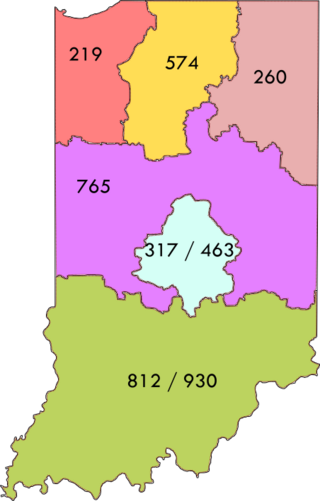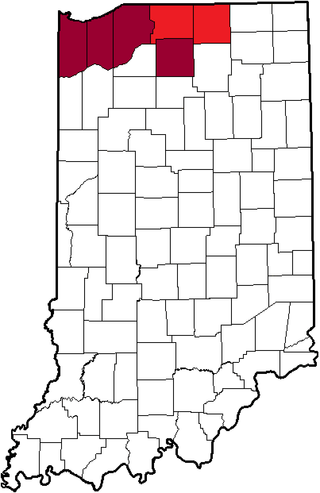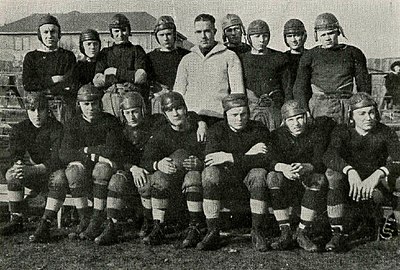1920-1936: The North and mythical state champions
From the late 1800s through 1919, Indiana high school football teams often played fewer than five games per year and many times skipped entire seasons. Pre-1920 games often featured high school teams playing semi-pro club teams, college teams, and even intramural scrimmages. Various teams made state championship claims, but most were unfounded until organized leagues and verified games became commonplace beginning with the 1920 season. By that year, as many as 26 high schools in northern Indiana — stretching from Fort Wayne to East Chicago — were annually compiling standings and functioning as the state’s first organized football conference. These northern football teams frequently defeated powerhouse teams from other states and were rarely defeated by Indiana teams from outside the league. For example, From 1921 to 1926, Gary Emerson never lost a game to an in-state team. The winner of this early super conference usually claimed the "mythical" state football championship prior to 1928. Indeed, when an Indiana mythical state championship game was played between the best teams of northern and southern Indiana (in 1923, 1924, 1927, 1929, and 1930) the northern league champion won every time.
In 1926, for one year, the league standings included power teams from around the state, including Evansville Central, Richmond, Indianapolis Tech, Marion, and Muncie, all of whom finished behind league leaders Mishawaka and Gary Emerson. In 1927, many of these same northern teams – from Elkhart to East Chicago – officially formed the Northern Indiana Conference (NIC), with its champion going on to dominate the #1 final ranking in the AP and UPI polls well into the 1960s.
By the early 1930s, the Evansville and Terre Haute areas were also well established as Indiana high school football hotbeds. Clinton (north of Terre Haute) won three titles between 1928 and 1933, and Evansville Memorial, best in the south in 1937, defeated McKeesport, champions of Western Pennsylvania, 21-0, in what some newspapers called the mythical national championship.
The following teams were widely considered the state football champions: Schools in italics are now consolidated or defunct.
- 1920 - Wabash4 and Mishawaka1
- 1921 - Gary Emerson1 and Gary Froebel1
- 1922 - Gary Emerson1 (2)
- 1923 - Gary Emerson² (3)
- 1924 - Elkhart (Central)²
- 1925 - Mishawaka1,4 (2)
- 1926 - Mishawaka1 (3)
- 1927 - Gary Froebel² (2)
- 1928 - Clinton³
- 1929 - Gary Mann²,³
- 1930 - Gary Emerson²,³ (4)
- 1931 - South Bend Central4
- 1932 - Clinton³ (2)
- 1933 - Clinton²,³ (3)
- 1934 - South Bend Central1,4 (2) and Terre Haute Garfield4
- 1935 - Evansville Memorial²,³
- 1936 - Gary Mann5 (2)
1NIC Champion
2Winner of arranged post-season North-South Mythical State Championship Game
- 1923 - Gary Emerson 7, Muncie Central 0
- 1924 - Elkhart (Central) 28, Bicknell 6
- 1927 - Gary Froebel 70, Indianapolis Shortridge 0
- 1929 - Gary Mann 38, Fort Wayne Central 0
- 1930 - Gary Emerson 21, Logansport 7
- 1933 - Clinton 6, East Chicago Washington 6, tie
- 1935 - Evansville Memorial 13, Fort Wayne Central 0
3Winner of Indianapolis Times & IHSAA ‘Most Outstanding Team in Indiana’ Trophy – 1927, 1928, 1929, 1930, 1932, 1933, and 1935
4Mythical State Champions named by “various Indiana newspapers,” according to AlmanacSports.com – 1920, 1925, 1931 and 1934
5NIC East-West Playoff Champion - 1936 (no other claims found)
( ) Total State Championships

Mishawaka is a city on the St. Joseph River, in Penn Township, St. Joseph County, in the U.S. state of Indiana. The population was 51,063 as of the 2020 census. Its nickname is "the Princess City." Mishawaka is a principal city of the South Bend-Mishawaka, Indiana — Michigan, Metropolitan Statistical Area.

The Watersheds of Indiana consist of six distinct Indiana watershed regions that drain into five major bodies of water.

The Diocese of Fort Wayne–South Bend is a Latin Church ecclesiastical territory, or diocese, of the Catholic Church in north-central and northeastern Indiana in the United States.

Reitz Memorial High School or simply Memorial High School (MHS) is an inter-parochial Catholic high school on the east side of Evansville, Indiana. It sits on land bought with money donated by Francis Joseph Reitz in 1922 in memory of his parents, John Augustus and Gertrude Reitz. The school officially opened its doors on January 5, 1925. It is part of the Diocese of Evansville.

Northern Indiana is a geographic and cultural region that generally comprises the northern third of the U.S. state of Indiana and borders the states of Illinois to the west, Michigan to the north, and Ohio to the east. Spanning the state's northernmost 26 counties, its main population centers include Northwest Indiana, Michiana, and the Fort Wayne metropolitan area.

Area code 765 is a telephone area code in the North American Numbering Plan (NANP) for the central part of the U.S. state of Indiana. The numbering plan area comprises a horseshoe-shaped region of twenty counties in Central Indiana except for the Indianapolis area, which is served by area codes 317 and 463. Some cities included are Anderson, Connersville, Crawfordsville, Frankfort, Greencastle, Kokomo, Lafayette, Marion, Muncie, New Castle, Richmond, and West Lafayette. The area code was created in 1997 in a split of area code 317.
In 1973, the Indiana High School Athletic Association (IHSAA) established a three class state playoff system in football. In 1983, the tournament split into four classes, in 1985 into a five class system, and in 2013 into a six class system, with 6A for big schools and 1A for the smallest schools. This page represents all smaller school class tournament champions.

The Northern Indiana Conference (NIC) is a high school athletic conference that was founded in 1927 and spanned from as far west as Hammond and Gary to South Bend/Mishawaka and Elkhart to the east and south to Plymouth. Since its start in 1927, a total of 32 separate schools have at one time called the NIC home. From its inception until 1963, the conference had been divided into East and West divisions. The West Division left to form the Northwestern Conference in 1963. With membership dwindling to 7 members by the 1970s, the conference added former members of the Northern Indiana Valley Conference to its ranks. Currently, every former NIVC member is now a part of the NIC except for South Bend Jackson, which closed in 1973, and South Bend LaSalle, which joined the NIC in 1977, but closed in 2001.

The South Bend–Mishawaka Metropolitan Statistical Area, sometimes referred to as Michiana, as defined by the United States Census Bureau, is an area consisting of two counties – one in northern Indiana and one in southwest Michigan (Cass), anchored by the cities of South Bend and Mishawaka in Indiana. As of the 2010 census, the MSA had a population of 319,224.
The Indiana High School Football Conference was an Indiana High School Athletic Association (IHSAA)-sanctioned conference founded in 1926 by 10 members. The founding members were:








